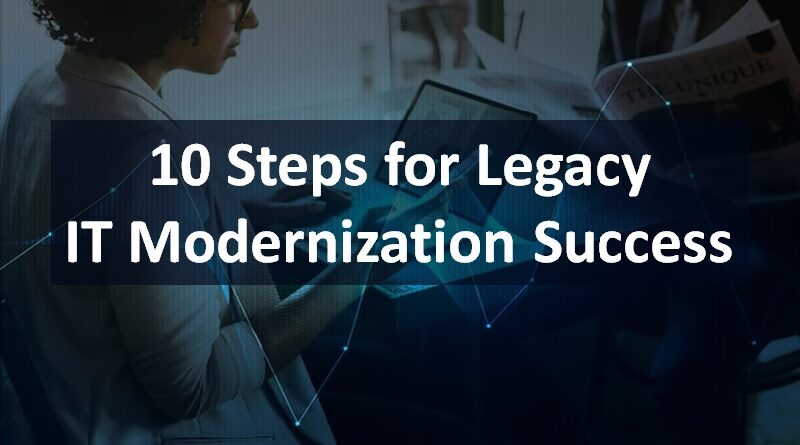10 Steps for Legacy IT Modernization Success
IT Modernization Success
Although the thought of mainframe migration can be intimidating, it is a crucial step that businesses must take to remain flexible and competitive. Tim Jones, MD of Advanced’s application modernization division, explains how businesses may better manage the upgrading of their IT infrastructure.
Due to the legacy skills shortage, a lack of interoperability, technical debt, or software entropy, organisations spend anywhere between 60 and 80 percent of their corporate IT budgets managing legacy programmes. However, 80% of corporate data worldwide still lives on or comes from mainframes, demonstrating a dated IT strategy and attitude. Despite enterprises’ increased desire to upgrade their systems, many programmes still fail or have delays as a result of poor planning, a lack of knowledge of the legacy environment, or a lack of mainframe modernization competence. Others still don’t fully understand the advantages of modernity.
The epidemic highlighted how more and more corporations struggled with modernization. They overestimated the problems and the processes necessary for a successful migration, which is to blame for this. One of these issues is the growing divide between really agile, cloud-based firms that can scale more readily and innovate, and others that are still constrained by clumsy, rigid, monolithic systems and architectures and will continue to lag behind.
IT leaders and managers will need to prioritise modernization efforts in order to realise the full potential of their organisations in order to even consider competing with new entrants and keeping up with shifts in the digital transformation of the future, not to mention saving annual costs in the process. In light of this, the ten actions listed below should be prioritised before beginning the modernisation process.
1. Recognize the organization’s utilisation of various systems and apps.
The first step in any application modernization project is to identify the systems and tools currently in use by the company. Leaders must audit the primary (COBOL, CA Gen, Natural, etc.) and secondary programming languages (Easytrieve, Assembler, etc.), including where and how these languages are used, as well as how the data infrastructure is stored (files, relational databases, etc.) and used in the organisation, to ensure that all systems and applications are accounted for.
2. Focus on the end result.
The secret to a successful modernization project is having a clear understanding of both the pipeline and the project’s final aim. 85 percent of organizationsOpens a new window are now planning or have just finished a modernisation project. The secret to success? Having a clear knowledge of the overarching objective and the ensuing inquiries
- What does success in this situation mean?
- Which habitat is more beneficial to the environment?
- What does the DevOps pipeline look like?
- What other elements might have an impact on modernization efforts?
3. Stick with the project
Legacy application modernization projects require planning, getting ready, and smart solutions, much like any other undertaking. Automated testing is the most effective technique to avoid losing time during post-migration. Factoring this in at the beginning is essential.
4. Obtain executive support
It can frequently take a deliberate effort from IT executives to gain the support of the leadership, according to 38% of organizations Opens a new window that claim they are unaware of the commercial advantages of cloud migration and IT in general. Executive buy-in should continue to be a top focus for the entire team since it keeps projects moving forward. Making a compelling case for why this project is necessary can be done by presenting data and figures that indicate how the organization’s technology affects financial performance. IT leaders should remember to ask for their feedback on processes and other operational matters while doing this as it may be extremely helpful in defining the project’s scope and articulating its value and return on investment.
5. Be prompt in resolving any concerns that may occur.
Any modernization project will inevitably face challenges; however, in order to shorten the time it takes to complete, businesses need make sure they have the right tools as well as knowledgeable partners who can assist them along the way.
6. Prepare test cases in advance.
Never undervalue the impact of thorough testing. Testing would take up around 50% of the procedure in a typical modernization project. In the end, automated testing solutions aid in the creation of test data and scripts by utilising already-existing testing resources and procedures. The correct documentation of all test cases pertaining to the mainframe conversion should also be ensured by organizations using dedicated resources.
7. Utilize incident tracking software
Teams can ensure more accountability and reportability for any concerns that may arise by putting in place an incident-tracking solution, which also provides appropriate methods for resolving them. Incidences can now be searched for better visibility.
8. Everyone should be a part of the mainframe ecosystem.
Roadblocks can be avoided by involving all internal stakeholders and delivery teams early on. Due of their familiarity with internal restrictions, these team members may assist with internal processes, lead times, change windows, lock-down timelines, and other constraints.
9. Modernize only what is necessary.
Modernization is a fun project, but it’s crucial to keep it in check and just update what’s necessary. Leaders can assist by separating “input files” from other files because only those need to be converted. Automated data migration can be used to accomplish this, which will keep the project on schedule and within budget.
10. Determine ROI and monitor development
Reducing risk and hastening the project’s return on investment are achieved by further identifying and calling out services. This phase, when used with the automatic documentation tools outlined earlier, will highlight connections and reduce work.
In the end, there isn’t really a single secret to a successful modernization journey, and the industry still has a ways to go before it can genuinely guarantee that each organisational pillar and system is nimble and modern. However, the project as a whole lays the groundwork for companies to prosper in the data-driven digital economy of today with the appropriate strategy and approach.




